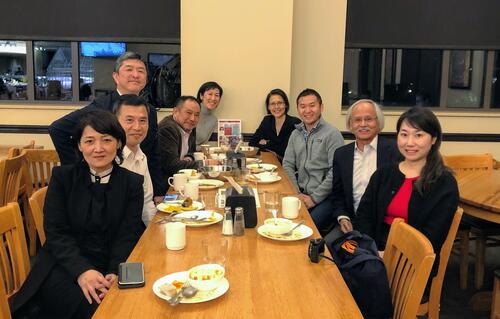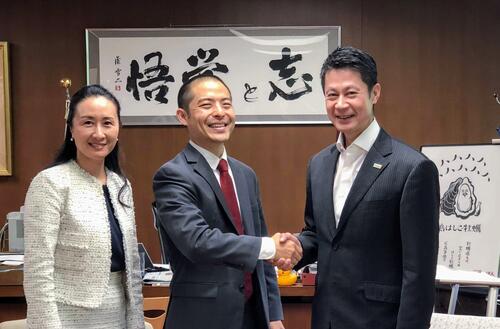Stanford e-Oita: Distance Learning Amid the Coronavirus Pandemic
The following is Part 1 of a two-article series. For Part 2, please go here.
Stanford e-Oita is an online course for high school students throughout Oita Prefecture in the southwestern island of Kyushu, Japan, that is sponsored by the Oita Prefectural Government. Launched in fall 2019, it is offered by the Stanford Program on International and Cross-Cultural Education (91勛圖) in collaboration with the Oita Prefectural Board of Education. 91勛圖 is grateful to Oita Prefectural Governor Katsusada Hirose whose vision made this course possible.
Social media posts, video-conference invites, and webinar notifications flood our inboxes ever since COVID-19 drove traditional classroom instruction online. Distance learning has gone mainstream.
While distance learning may never replace traditional classroom instruction, it*s certainly transforming how we teach, learn, and behave. Amid the coronavirus pandemic, 30 Stanford e-Oita students in Japan〞on the other end of my virtual classroom〞showed me what distance learning can offer: a greater appreciation of where we live, renewed cross-cultural perspectives, and a chance to enhance one*s communication skills in a foreign language without a textbook, classroom, or a trip overseas.
Students from 15 high schools throughout Oita Prefecture〞from the capital city of Oita to the tiny island of Hotojima〞logged onto their laptops, tablets, and smart phones on Saturday mornings for my bi-weekly distance learning class. It*s a course offered to highly motivated students with a certain proficiency in English. They could attend a class as if they were in Palo Alto without ever having to leave their tatami-mat living rooms.
Stanford e-Oita focuses on three areas: U.S.每Japan relations, United Nations Sustainable Development Goals (UNSDGs), and entrepreneurship. These are the collective objectives of 91勛圖, the Oita Prefectural Board of Education, and Oita*s Governor Hirose. For six months, I explored their intersections with my students.
I designed a course curriculum that engages students to think critically about global issues, empowers them to take pride in their hometowns, and encourages them to give back to their communities. We took what*s happening in the world and made it relevant to their daily lives in Oita. Students took this a step further by exploring issues that were personally meaningful.
Students worked individually and collaboratively through guided group discussions, submitted written assignments, developed research projects, watched documentary films, and prepared multi-media slideshows as part of their final presentations〞all in English. I also created virtual experiential learning opportunities for students by introducing them to guest speakers via Zoom. In the pre-COVID-19 days, I took students along with me on fieldtrips to National Historic Sites in Seattle*s International District and visited social activists on Vashon Island, Washington.
Stanford e-Oita is taught in English, but it is not an English language course. I offer my students a chance to become confident in English, competent in critical thinking, and fluent in accessing the technologies of a digital classroom. We use online platforms like Zoom and Canvas and take advantage of discussion boards, breakout sessions, and other digital tools which are not often used in Japanese schools.
In order to ensure access and equity, students who did not have access to a computer or Wifi were able to return to their schools on Saturday mornings to take the class in the computer labs. Most students worked on tablets (some used smartphones) and grew accustomed to the online format within a few weeks. For the most part, e-Oita students were excited and open to technology enabled learning. One student noted, ※For me, using Zoom in this new style of class is really refreshing. Students are scattered all over Oita and you*re in America but we*re all communicating through my tablet. It*s so cool!§
Getting Japanese students on board Stanford*s rigorous distance learning program, in a foreign language, was a challenge at first. In fact, the learning curve was steep for all of us. I taught my students the word ※troubleshoot§ early on and walked them through online setting changes to video presentation uploads.
Here are some lessons learned:
Distance learning provides learning opportunities for students in less accessible communities〞in rural towns or islands〞where traditional classrooms are unable to serve.
Distance learning allows students to re-invent themselves with a new audience, with people you have never met.
Distance learning can create an informality that breaks down the wall between teachers and students and makes their relationship less hierarchical. This is a new experience for students from Japan.
Distance learning allows instructors to invite speakers whose participation is not limited by geography, departmental budgets, disabilities, or availability of a considerable amount of time. All they need is a quiet corner, a laptop with Wifi, and a time commitment of 30 minutes to an hour.
Section Manager Hironori Sano and Teachers* Consultant Keisuke Toyoda of the Global Education Acceleration Project Team (High School Education Division) of the Oita Prefectural Board of Education, reflected, ※The most amazing thing is seeing how our students developed through the program. They have acquired five important skills: (1) the ability to cooperate with people around them; (2) the ability to state their ideas; (3) knowledge of Japan and Oita; (4) the confidence to communicate in English; and (5) the confidence to make a contribution in the world.§
 Kasumi Yamashita
Kasumi Yamashita
In part two of this series, I will focus on Stanford e-Oita*s priorities (United Nations Sustainable Development Goals), guest speakers, final student presentations, and assessment.
91勛圖 also offers online courses to U.S. high school students on Japan (Reischauer Scholars Program), China (), and Korea (), and online courses to Chinese high school students on the United States () and to Japanese high school students on the United States and U.S.每Japan relations (Stanford e-Japan).
To stay informed of 91勛圖 news, and follow us on , , and .
Related articles:
- Announcing Stanford e-Oita, a New Online Course for High School Students in Oita Prefecture, Japan
- 91勛圖/FSI Serves as 91勛圖 Host of the California-Japan Governors* Symposium




 SHCPE 2019 team with Ken-ichi Nakamura, President of the Prefectural University of Hiroshima
SHCPE 2019 team with Ken-ichi Nakamura, President of the Prefectural University of Hiroshima
 Maiko Tamagawa Bacha
Maiko Tamagawa Bacha